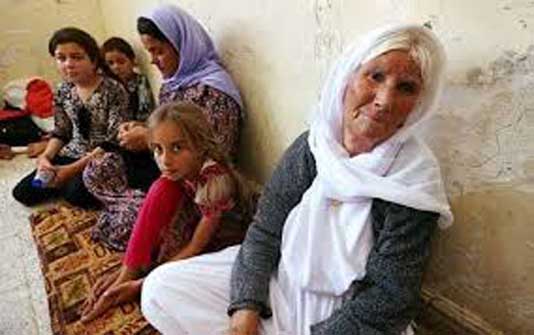LALISH, Iraq, July 14, 2019 (BSS/AFP) – It has been five years since the
Islamic State group swept across Sinjar, a mountainous corner of northwest
Iraq home to an ethno-religious minority known as the Yazidis.
Little was known about the Yazidis prior to the jihadists’ infamous
brutalisation of the community, which included killing men en masse and
abducting thousands of girls and women as “sex slaves”.
As the sect prepares to mark five years since the crisis, here is some
background.
– An ancient faith –
The Yazidi faith emerged in Iran more than 4,000 years ago and is a
“closed” faith, meaning one cannot convert to it.
Adherents believe in one God to whom they pray by facing the sun.
They also worship seven angels — especially Melek Taus, the Peacock
Angel.
In their traditional homeland Sinjar, this Kurdish-speaking sect relied
mainly on farming to get by.
Their holiest site is Lalish, a serene stone complex of shrines and
natural springs in Iraq’s mountainous northwest where visitors must walk
barefoot.
The faith is led by a five-member High Spiritual Council based in nearby
Sheikhan, which includes both the worldwide “prince” of Yazidis and Baba
Sheikh, their religious chief.
Yazidis are organised into three castes — sheikhs, pirs, and murids —
and cannot wed across them or outside the sect. Children are Yazidi only if
both their parents are.
Over time, the faith has integrated elements from other religions:
children are baptised in holy water like Christians, boys are circumcised and
men can take up to four wives like Muslims.
– Yazidis in numbers –
Of the world’s nearly 1.5 million Yazidis, the largest number — 550,000 –
– lived in Iraq, with smaller numbers in Kurdish-speaking areas of Turkey and
Syria.
Decades of emigration have seen sizable Yazidi populations spring up
across Europe too, chiefly in Germany which is home to around 150,000.
Other communities can be found in Sweden, France, Belgium and Russia.
But since IS swept across Sinjar in 2014, around 100,000 emigrated from
Iraq to Europe, the US, Australia and Canada.
Around 360,000 still live in displacement camps scattered across
northwestern Iraq.
Only a few thousand have been able to return to Sinjar, where most homes
remain in ruins and services like electricity, hospitals and clean water are
scarce.
– Long persecuted –
Their status as non-Arabs and non-Muslims has placed Yazidis among the
most vulnerable minorities in the Middle East, where Orthodox Muslims have
derided them as “devil-worshippers”.
Yazidis say they have been subject to 74 “genocides”, including the IS
attack in 2014.
One of the worst, according to the High Spiritual Council, saw 250,000
Yazidis perish several hundred years ago.
They were also persecuted by the Ottoman Empire in the early 1900s and
more recently by Iraqi dictator Saddam Hussein, whose iron-fisted rule
between 1979 and 2003 forced thousands of Yazidi families to flee.
– IS and its aftermath –
IS seized Sinjar in August 2014, unleashing a brutal campaign against the
Yazidis that the United Nations has said could amount to genocide.
According to religious authorities, more than 1,280 Yazidis are confirmed
to have been killed by IS, leaving several hundred children orphaned. Nearly
70 shrines were destroyed.
Since IS lost its last shred of territory in Syria in March, dozens of
Yazidi women, girls and boys have been freed and reunited with their families
in Iraq.
More than 6,400 Yazidis were abducted, of whom around 3,300 — mostly
women and girls — have returned alive.
The rest remain missing.
More than 70 grave sites have been identified across Sinjar containing the
remains of IS victims, of which 12 have been exhumed as part of a probe
carried out by the UN, Iraq’s government and other agencies.
Some women who had been forced to bear the children of IS fighters have
left them in neighbouring Syria, as they would not have been accepted by the
minority.



